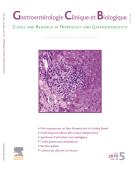Avantages et inconvénients des différentes méthodes diagnostiques de l'infection à H. pylori - 29/02/08
Jean-Dominique de KORWIN
Mostrare le affiliazioniLe diagnostic de l'infection à H. pylori repose soit sur des méthodes nécessitant la réalisation de biopsies gastriques lors de la gastroscopie (anatomie pathologique, culture, test rapide à l'uréase, PCR), soit sur des techniques non invasives (sérologie, test respiratoire à l'urée 13 C, recherche d'antigènes dans les selles). L'examen anatomopathologique est utilisé en routine sur les biopsies, permettant aussi de caractériser les lésions inflammatoires muqueuses. Le test rapide de l'uréase, moins sensible, mais spécifique, est réalisé par le gastro-entérologue principalement en cas d'ulcère duodénal, suivi de l'anatomie pathologique en cas de résultat négatif. La mise en culture des biopsies a pour avantage de pouvoir tester la sensibilité aux antibiotiques. Les méthodes non invasives ne permettent pas de déterminer la nature de la maladie qui peut être associée à l'infection. La sérologie, peu onéreuse, a un intérêt dans le dépistage ou pour la confirmation de l'infection en cas de résultats équivoques des autres méthodes (ulcère hémorragique, traitement antibiotique ou antisécrétoire...). Le test respiratoire à l'urée 13 C est la méthode la plus performante quelle que soit la classe d'âge. La recherche d'antigènes d' H. pylori dans les selles est une technique prometteuse en raison de performances voisines de celles du test respiratoire, de sa simplicité et de l'utilisation d'anticorps monoclonaux. Le contrôle d'éradication doit être effectué au plus tôt 4 semaines après la fin du traitement antibiotique, en respectant un délai minimal de 2 semaines après traitement antisécrétoire. Si l'endoscopie est nécessaire, la réalisation d'une culture avec antibiogramme, en plus de l'anatomie pathologique, est conseillée pour contrôler l'éradication. La recherche de marqueurs de virulence de la bactérie est encore du domaine de la recherche.
Advantages and limitations of diagnostic methods of Helicobacter pylori infection |
The diagnosis of H. pylori infection is based on methods requiring gastric biopsies performed during endoscopy (histology, culture, rapid urease test, PCR) or on non-invasive methods (serology, 13 C urea breath test, stool antigen test). Histology is routinely performed on gastric biopsies, also allowing the description and the classification of the gastric inflammatory mucosal lesions associated with H. pylori. The rapid urease test is less sensitive but specific. It can be done by the gastroenterologist himself, mainly when a duodenal ulcer is found at endoscopy, and may be followed by histological testing in case of a negative result. The culture of biopsies may be helpful in determining in vitro patterns of antimicrobial resistance and sensitivity in planning second line treatment for a patient after eradication failure. Non-invasive methods are not appropriate for determining the underlying disease, which may be associated with H. pylori infection . Serological tests are widely available and cheap, and may be helpful in screening populations or in confirming the presence H. pylori infection in case of equivocal results of the other diagnostic methods due to bleeding ulcers, antibiotic and/or antisecretory treatments. The 13 C urea breath test is the most accurate method in patients irrespective of age. Stool antigen testing is a promising method because its diagnostic performances approach those obtained with urea breath test. This technique is easy to perform, and its accuracy may be improved by the use of monoclonal antibodies recently proposed for capturing H. pylori antigen in stool specimen. The eradication control is recommended at least 4 weeks after the end of the eradication treatment or at least 2 weeks after antisecretory treatment to obtain high sensitive results. If endoscopic control is necessary, a biopsy culture with antibiotic testing is recommended in combination with histology, because of the actual development of antibiotic resistances. Looking for H. pylori virulence markers remains a promising research topic but is not yet recommended in routine practice.
Mappa
© 2003 Elsevier Masson SAS. Tous droits réservés.
Vol 27 - N° 3-C2
P. 380-390 - Marzo 2003 Ritorno al numeroBenvenuto su EM|consulte, il riferimento dei professionisti della salute.

